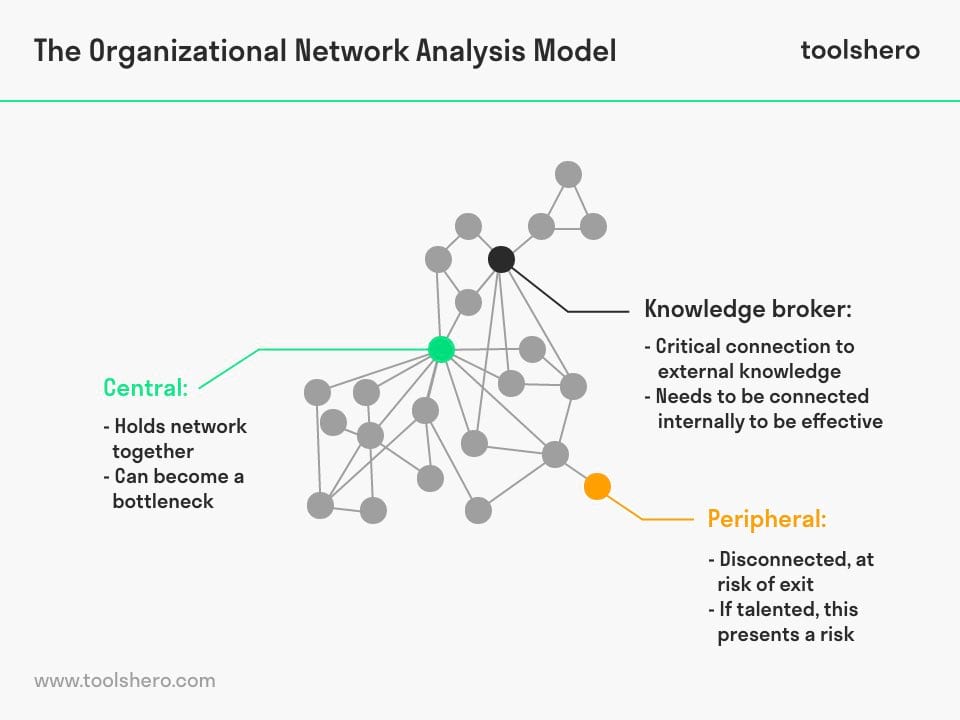Organizational Network Analysis (ONA)

Organizational Network Analysis (ONA): this article provides a practical explanation of Organizational Network Analysis (ONA). Next to what it is, this article also highlights an Organizational Network Analysis example, the topic network structure versus hierarchy structure, the use within a case study, the advantages and a short summary with some highlights about this reasearch tool. After reading, you’ll understand the basics of this strategy tool. Enjoy reading!
What is Organizational Network Analysis (ONA)?
Organizational Network Analysis (ONA) is a structured method to identify and investigate communication networks and other socio-technical connections within an organisation. The result of such an investigation consists of statistical models of people, knowledge, resources groups and tasks in the organisational system.
The method is derived from social network theory and is aimed at dynamic network activities within organisations.
In every organisation, people trust and build on informal relationships. Whenever a problem or question arises, many people know how to find the right person who knows about all the ins and outs in the organisation. These spontaneous social connections are important and are the lifeblood of companies around the world.
By realising such collaborations and connectivity, the organisation is able to deploy expertise widely. Instead of an expert sharing knowledge with only the team of which they are part, the knowledge becomes accessible to everyone within the organisation.
The Organizational Network Analysis (ONA) is an effective way to visualise how these forms of communication and information flows spread through an organisation. Organisation networks consist of connections. When these connections are identified, it becomes possible to understand how information flows through the organisation and how the flow of information should move.
Organizational Network Analysis example
The image below is from a study by Professor Rob Cross and is an example of an Organizational Network Analysis (ONA) visualisation.

Figure 1 – Organizational Network Analysis Example
Organizational Network Analysis: network structure versus hierarchy structure
The Organizational Network Analysis (ONA) reveals connections within the organisation that cannot be identified from the hierarchical structure. This is also the method’s greatest strength. Every organisation has people who serve as a node. These people are critical elements when it comes to the exchange of ideas and information.
These connections deliver value at all times when information is exchanged. The most important elements of Organizational Network Analysis (ONA) are briefly explained below.
1. Central nodes
The central nodes in the model represent the people that everyone always knows where to find.
For example, in the event of connection problems, everyone knows how to find the IT expert, in the event of communication problems everyone knows how to find the talent communication employee, and in the event of mathematical problems, everyone knows how to find the mathematics expert, etc.
These people are able to share a lot of information and can be located in all layers of the organisation. They are often popular and are deeply involved in business developments and news.
2. Knowledge brokers
Knowledge brokers are those who build bridges between people. These are people with specific knowledge or a lot of general knowledge.
Without knowledge brokers, the sharing of ideas and information generally comes to a halt.
3. Peripheral
Peripheral refers to people with a high potential who can easily be overlooked because their potential has no connection with the rest of the company. An example of this are Java coders.
They are often the only ones in the organisation with relevant knowledge about their field and others have difficulty helping them. If these talents are not given the opportunity to learn other things, they will stagnate product development and will be easily convinced to apply their talents elsewhere.
4. Ties
Ties are both the formal and informal relationships between the various nodes. By ensuring that these relationships function optimally, an organisation can ensure that valuable information flows can easily take place.
The nodes, ties and knowledge brokers form the core elements of Organizational Network Analysis (ONA). The aim of the method is to clearly identify the relationships between these elements. This makes it much easier to optimise critical connections to ensure information transfer is smooth and effective. Any barriers and problems can be identified and remedied at an early stage.
Different employee networks
The connections and relationships, the frequency and strength at which communication is used, can be measured over several types of networks of which employees are part. The most important networks are explained below.
1. Work networks
These networks are made up of people that employees work with to exchange information to complete tasks and activities. Internally these are, for example, colleagues or team members, departments and others at different level of the hierarchy. Externally, these are, for example, customers, partners or suppliers.
These types of networks are continuous networks, in which interactions almost always take place constantly. This is in contrast to the two types of networks below.
2. Innovation networks
Innovation networks are informal connections between different parties for the development of sustainable innovation. This concerns the generation of ideas to the implementation of various projects and initiatives. These players provide strategic direction and support and build bridges throughout the organisation.
The external innovation network consists of external partners, customers and organisations that collaborate to develop new ideas, products, services or business models.
3. Expertise networks
Expertise networks are networks that connect individuals with experts to provide valuable information or support on work-related issues. The experts in this network have different types of information and knowledge.
This is about knowledge about business processes, politics, psychology, procedures and more. These people themselves do not require any further formal expertise.
Organizational Network Analysis (ONA) case study
An Organizational Network Analysis is used in various ways by executives, managers, consultants and other professionals. Various tools are available for developing network visualisations. This allows managers to visualise their own networks themselves.
Most of these tools are relatively inexpensive to use, as long as the correct information is properly identified.
Innovation case studies
Several case studies have shown that psychological safety among employees is the most important condition for an innovative team.
Google was the first company to publish a study on this subject. Amy Edmondson is the most important person when it comes to research in this field.
ONA is used in the studies to understand how a team as a unit creates psychological safety for its members.
This method is more accurate than traditional studies and also makes it possible to measure the emotional impact that colleagues have on each other in the most objective way possible.
The method also helps leaders to understand whether there are enough healthy connections and other core elements to develop an innovative team.
Advantages of the use of an Organizational Network Analysis
The use of Organizational Network Analysis (ONA) has a large number of advantages. The main advantages are described below.
1. Increased manoeuvrability by conducting an Organizational Network Analysis
Organisational Network Analysis (ONA) can help in identifying critical areas where improvement in employee collaboration could be desired.
In addition, it provides a roadmap to stimulate change through key players in the network. This is crucial for the change process to run smoothly and accurately. Effective change is necessary for an organisation to be able to quickly respond to new market developments.
2. Innovation stimulation
Organizational Network Analysis assesses the way information flows occur, ideas are conceived and how problem solving processes and decision-making mechanisms work within an organisation. In addition, critical points can be quickly assessed and revealed to stimulate connectivity between players in the innovation network.
3. Sales growth stimulation
Organizational Network Analysis can ensure that collaborations are identified that generate revenue growth.
4. Collaboration efficiency
Organizational Network Analysis improves collaboration between functions, expertise and locations. By understanding the basics of collaborations, companies can collectively reduce the potential for overload of central roles and people and improve performance.
Summary of Organisational Network Analysis (ONA)
Organizational Network Analysis (ONA) is a method to identify relationships between employees and the external world. This includes communication networks, but also other social connections within an organisation.
Many problems in business are solved because people simply know and are able to reach the right people. These often casual relationships are critical to business for a number of reasons.
When the organisational networks are optimised, the organisation becomes more agile and flexible and more successful in innovation and realising revenue growth.
Generally speaking, there are three types of networks. The work networks are traditional collaborative relationships within an organisation. Innovation networks are informal connections between different parties working on sustainable innovation.
Finally, there are networks of expertise. This includes connections between individuals and experts for the transfer of valuable information and other help.
Now it is your turn
What do you think? Are you familiar with the explanation of Organizational Network Analysis (ONA)? Do you recognise the usefulness and potential behind this method? What other theories and methods about the dynamics between employees are you aware of? Do you think many organisations are neglecting potential because of inefficient business networks? Do you have any tips or comments?
Share your experience and knowledge in the comments box below.
More information
- Bergenholtz, C., & Waldstrøm, C. (2011). Inter-organizational network studies—a literature review. Industry and Innovation, 18(6), 539-562.
- Cross, R. L., Singer, J., Colella, S., Thomas, R. J., & Silverstone, Y. (2010). The organizational network fieldbook: Best practices, techniques and exercises to drive organizational innovation and performance. John Wiley & Sons.
- Cross, R., Kaše, R., Kilduff, M., & King, Z. (2013). Bridging the gap between research and practice in organizational network analysis: A conversation between Rob Cross and Martin Kilduff. Human Resource Management, 52(4), 627-644.
- Tichy, N., & Fombrun, C. (1979). Network analysis in organizational settings. Human relations, 32(11), 923-965.
How to cite this article:
Janse, B. (2021). Organizational Network Analysis (ONA). Retrieved [insert date] from Toolshero: https://www.toolshero.com/strategy/organizational-network-analysis/
Published on: 01/03/2021 | Last update: 01/16/2024
Add a link to this page on your website:
<a href=”https://www.toolshero.com/strategy/organizational-network-analysis/”>Toolshero: Organizational Network Analysis (ONA)</a>













One response to “Organizational Network Analysis (ONA)”
Great Article!